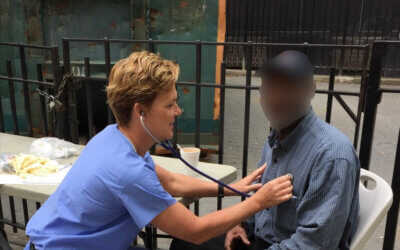9 Tips for a Realistic New Year’s Resolution
Deciding on a realistic and affordable New Year's resolution isn't always easy. Whether it's your physical, mental or financial health, Chapters Health System provides some ideas and tips to meet your goals in 2024.

It’s that time of year again. Leaves are falling, families are coming together, pumpkin spice returns, and everyone is preparing for the rush of the holidays. New Year’s Day is a particularly unique holiday in that group with the practice of setting a New Year’s resolution. Perhaps your goal is to be physically healthier. Maybe you want to focus on improving your mental health or finances. These are all elements of your life that contribute to your overall wellness. An honest effort to improve one or all of them can go a long way to giving yourself the happy new year everyone wishes for. The first step to accomplishing this is setting realistic, measurable goals. Not everyone has the time or money for every kind of resolution. A family member taking care of a chronically ill loved one is a perfect example. What kind of realistic, affordable goals can they set for 2024? With that in mind, we go over the nine most healthy and realistic New Year’s resolutions to improve your physical, mental and financial wellness.
New Year’s Resolution: Physical Wellness
Being more physically active is one of the most common New Year’s resolutions you can think of and for good reason. There are measurable goals that come with being more active. Maybe you want to reduce your blood pressure or just lose some pounds. There are the obvious benefits such as improvements to cardiovascular health and the prevention of diabetes.
Additionally, clinical studies continue to reveal more mental health benefits from regular exercise. Stress, depression, anxiety and even the risk of Alzheimer’s disease can all be mitigated by regular exercise. Now, what is regular exercise? The benefits are clear, but I’m sure you may wonder, how do I get there? Here are some ways to make the journey easier.
1. Start Small
Starting small is always a good strategy for fulfilling your New Year’s resolution. Setting realistic, achievable goals is always a sure path to progress. For most adults, The Centers for Disease Control and Prevention recommends 150 minutes of moderate exercise per week, such as brisk walking. Remember, this is just a guideline, and some physical activity is always better than none. Furthermore, not everyone can work out 30 minutes a day every week starting out, especially if they aren’t used to regular exercise. Start with small goals like working out two days a week, then increase as your body becomes more comfortable. Also, remember you don’t have to accomplish your workout goal all at once. You can accomplish it intermittently throughout the day.
2. Join a Class or Exercise with a Friend
Having companions to join your fitness journey is always beneficial. That could mean simply setting a workout schedule with a friend or joining a class where other people have the same fitness objectives as you do. It could also mean just having a friend to go on more walks with. Having a partner or group can do wonders toward achieving your fitness goals. It keeps you on schedule, holds you accountable and provides extra motivation and support.
3. Spend Time Doing Physical Activity You Actually Enjoy
Not everyone enjoys sweating it out in a gym for 30 minutes and that’s fine. There are other ways to get the exercise you need. One of the best ways is to just get outside. Hiking, kayaking, standup paddleboarding and roller skating are all examples of activities that can provide you with moderate exercise and they are different from the traditional exercises such as jogging, swimming and biking. In fact, research from the American Council on Exercise (ACE) shows kayaking, which is a very popular pastime across the country, is a good alternative to more traditional cardiovascular exercises if performed correctly and with intent. So, whether your activity is on the water, land or pavement, find something you simply like doing and commit some time to it. If you enjoy it, you’ll likely keep doing it.
New Year’s Resolution: Mental Health
Improving your mental health is a worthwhile resolution as well. According to the American Psychiatry Association, around 40 percent of American adults are stressed about their mental health with 29 percent expected to make a mental health resolution in 2023. Here are some ways to help you achieve that goal.
1. Discover or Remember a Hobby that Makes You Happy
Studies have shown that hobbies during spare time can reduce cortisol levels, one of the most widely studied hormonal metrics for stress. In fact, one study, cited by Utah State University, showed cortisol levels dropped for 75 percent of participants when they took up artistic hobbies such as painting. Of course, art isn’t the only hobby that can bring you joy. Hobbies that include physical activities can also reduce stress and blood pressure. The mental health benefits increase even more when you take your chosen activity outdoors. With this in mind, set a goal to spend at least a few hours each week enjoying your hobby and be mindful of that time. If you find yourself scrolling on social media or watching television, remind yourself that this is time you can spend doing the activity that brings you joy.
2. Commit to Getting Better Sleep
Sufficient sleep helps the brain process information. That can influence your mood and emotional reactivity. According to the Sleep Foundation, poor sleep may also induce or exacerbate some mental health conditions such as depression, anxiety and attention deficit hyperactivity disorder (ADH. There are many tips to getting better sleep.
3. Volunteer
Never doubt the impact volunteering can have on your mental health. The National Alliance on Mental Health says volunteering reduces stress and helps you develop stronger self-esteem. Furthermore, a 2020 study conducted in the United Kingdom found even more reasons to volunteer. Researchers found people who volunteered were more satisfied with their lives and rated their overall health as better. Some of the participants reported having better mental health after just one month. There are many ways to volunteer. Not-for-profit organizations, such as Chapters Health, welcome volunteers who serve important roles. Hospice volunteers provide important assistance in supporting patients and families throughout their continuum of care. They can also assist the organization in other ways, such as honoring Veterans and First Responders and assisting with grief therapy activities.
New Year’s Resolution: Financial Wellness
Financial wellness may be the most difficult New Year’s resolution to follow through on because the price we pay for things is always changing, as are our circumstances in life. However, like our other New Year’s resolutions, you can achieve them if you set measurable goals and start small to build momentum.
1. Set a Number to Save or to Reach
This is easily a tip for many kinds of resolution. Identify a number you want to reach. While you could easily apply this strategy to other goals such as weight or blood pressure, what facet of our overall wellness is driven more by numbers than your finances? Setting a measurable goal in this regard is even more important. Instead of just saying “I’m going to save more” or “I’m going to improve my credit,” set a percent or number you want to devote to that goal. For example, commit to saving 10 to 15 percent of every paycheck and put that money into your emergency fund. Many financial advisers recommend saving at least 30 percent of every paycheck, but in 2023, that may not be feasible. You could also increase the contribution to your retirement account to meet your savings goals. Another good goal is to aim for a specific credit score that provides you with better opportunities.
2. Reset Your Budget
Budgets only work if you follow them and changing times also bring changes to your budget. Perhaps you got a promotion and earn more. Maybe your expenses are rising, and you need to cut back. Setting and tracking a budget for either scenario ensures you making the most of your money. Set a goal to collect receipts and track spending for at least one quarter of the year. Take that data and create a new budget. You may realize you have an opportunity to treat yourself at the end of a quarter or save more by cutting frivolous expenses. If you can, it’s also a good practice to review last year’s expenses before planning your budget.
3. Improve Your Financial Literacy
When I think about financial literacy and what to do with money, I often think of a piece of advice my grandmother gave me. She worked as an accountant at the IRS for many years.
“Money is a tool,” she once said. “Don’t spend it. Use it.”
Educating yourself on how to use your money may be one of the best financial goals you can set, and it doesn’t have to break the bank. Many states offer free financial literacy courses. If you set aside time for them, you may find pathways to achieving your goals.
Chapters Health System is committed to serving the needs of its patients, families, caregivers, health providers, partners and communities.
For more information, please call our helpful Chapters Health and HospiceHelp24® team at 1.866.204.8611 or Contact Us.
Keep Exploring
















